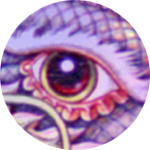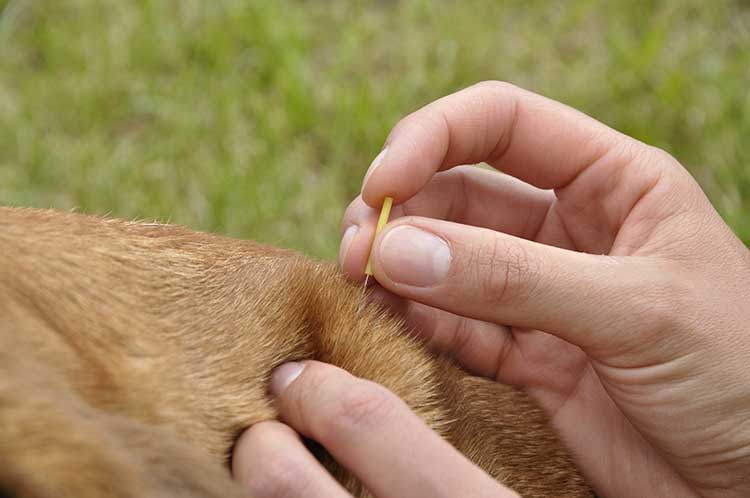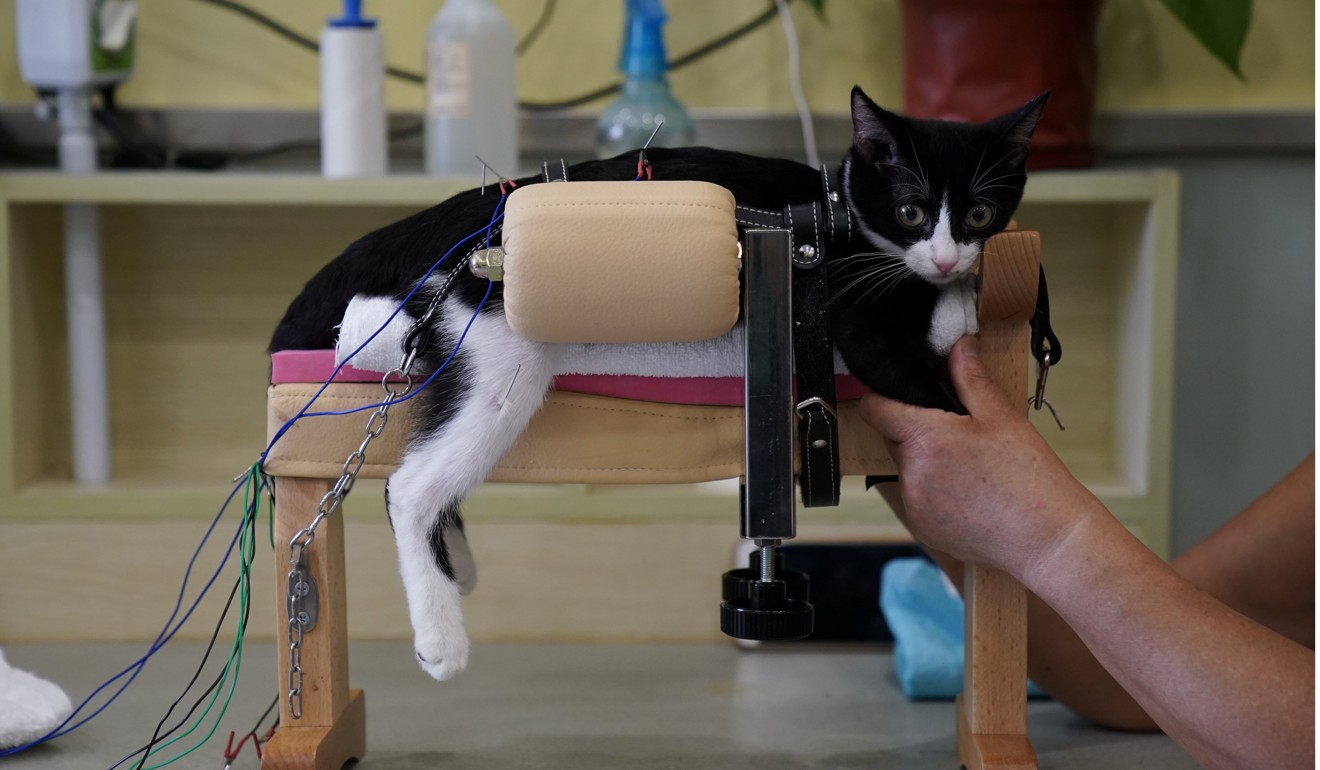Acupuncture for your pets
AMY PATTERSON 573-518-3616 Updated Jan 8, 2017

Amy Patterson, Daily Journal
Dr. Jean Liljegren, one of three veterinarians on staff at the Animal Medical Center of Park Hills, takes some time to bond with new patient Sammi before beginning his first acupuncture treatment.

Amy Patterson, Daily Journal
Veterinarian Dr. Jean Liljegren begins most acupuncture sessions by inserting the first needle in the middle of the animal’s head, slightly above the eyes. Stimulating this point creates a calming effect, as can be seen in Sammi's very relaxed face.

Amy Patterson, Daily Journal
Sammi checks out an acupuncture needle as veterinarian Dr. Jean Liljegren removes it from its sterile packaging. The needles are very thin, solid and sterile, and although they come in different sizes for small and larger animals, even the largest needles are still very slim.

Amy Patterson, Daily Journal
Adding a bit of electrical stimulation to acupuncture treatments is something Dr. Jean Liljegren does often, depending on the animal's condition and the goals of treatment. Adding electro stimulation to the traditional use of needles stimulates the acupuncture points more quickly and helps them stay stimulated longer.
All three of the veterinarians at the Animal Medical Center of Park Hills — Dr. Crystal Harding, Dr. Jennifer Daniels and Dr. Jean Liljegren — offer a full range of medical care and treatments for companion animals, but Liljegren, the newest member of the team, also offers something different than traditional “Western” veterinary care.
Liljegren, pronounced with a silent ‘j’, and who her clients typically refer to as “Dr. Jean,” is a fully-trained and licensed doctor of veterinary medicine (D.V.M.), but is also trained in traditional Chinese veterinary medicine, including acupuncture. She offers a more holistic approach to veterinary care than her traditional counterparts, integrating the use of Chinese herbal supplements, dietary recommendations and acupuncture with traditional veterinary care.
Although the practice of acupuncture has been around for centuries, it is still relatively new in the United States, especially within the veterinary field. It has garnered enough respect among veterinary professionals, however, to have gained recognition from the American Veterinary Medical Association (AVMA) as a legitimate form of treatment.
“Something that just happened in the last year is that the AVMA (the American Veterinary Medicine Association) has approved acupuncture as a sub-category of veterinary medicine,” said Liljegren. “So it’s getting more recognized and there’s great research going on both with herbs and with needles.”
Much of Liljegren’s “Eastern” approach centers around the use of acupuncture to treat a wide range of illnesses and medical conditions. In a nutshell, veterinary acupuncture stimulates the release of the body’s own pain relieving and anti-inflammatory substances.
According to the official website of the American Academy of Veterinary Acupuncture (AAVA), benefits of acupuncture also include improved blood flow to the tissues, oxygenation and the removal of metabolic wastes and toxins. Treatments involve the insertion of very thin, solid, sterile needles into body tissue where nerve bundles and blood vessels come together.
And unlike prescription and over-the-counter pain medications, there are no adverse side effects for a pet’s internal organs and no worries about unsafe interactions with any medications a pet may already be taking. Acupuncture can therefore be safely used to treat a variety of illnesses and medical conditions, including trauma and post-surgical pain, musculoskeletal, gastrointestinal, respiratory, urinary, skin and neurological issues. For cancer patients, it can also help alleviate pain, fatigue, nausea, vomiting and lack of appetite.
The goal of acupuncture is to help the body heal itself. From a Traditional Chinese Veterinary Medicine (TCVM) perspective, acupuncture encourages healing by correcting energy imbalances in the body. Acupuncture enhances blood circulation, nervous system stimulation, and the release of anti-inflammatory and pain-relieving hormones.
Liljegren takes extra time with her acupuncture patients, especially during the first appointment, asking questions of the human client to get to know her new patient’s medical history, typical behaviors and personality, along with current health status, before beginning any treatments.
One of Liljegren’s newest patients, a 13-year-old Beagle-mix named Sammi, has a history of chronic ear infections and a few bouts of illness with vomiting and diarrhea, but until about a year ago when he began to develop arthritis along his middle and lower spine, he lived most of his life without any major medical issues.
About one week before his first appointment with Liljegren, Sammi experienced a sudden and very painful episode in which he began to stumble around, losing control of his back legs.
After ruling out a stroke or a ruptured disc, Sammi’s traditional “Western” veterinarian prescribed a medication to treat overall pain and another drug to treat any possible nerve pain, in addition to the joint inflammation medication he was already taking.
Within about 24 hours, Sammi was walking more normally again and he continued to show some small improvements. His appetite, however, was almost non-existent. After about three days, the general pain reliever was discontinued because it was likely causing him nausea or other stomach upset. His appetite improved some, but Sammi’s overall condition didn’t seem to be improving much beyond walking more normally.
It was obvious Sammi needed more help to heal, but without some extensive diagnostic tests, the cause of the episode couldn’t be known. After it became clear that the episode would have some long-lasting implications for him in terms of mobility and physical discomfort, Liljegren’s advice was sought to see if acupuncture might help Sammi.
Liljegren tends to ask some non-conventional questions compared to veterinarians whose practice is more traditional, such as whether the dog seeks out sunny spots or tends to avoid them.
In discussing Sammi’s history, she asked, “How about heat or cool preferences, in general, over his lifetime?”
For dogs that tend to be strongly affected by heat or cold, she mentioned that some simple dietary changes can help balance out an animal’s body temperature.
Liljegren continued to ask questions about Sammi’s history in order to determine which areas of his body to target with the acupuncture needles.
“As I’m listening to you — and I ask weird questions sometimes — as I’m listening to you talk, I’m thinking of the different Chinese organ systems. So when you’re telling me he’s not eating very well, that can just be plain old Chi deficiency. With geriatric people and dogs, their appetites tend to not work very well … But if we have chronic G.I. issues over the years, that can be what we call a spleen Chi deficiency.”
Liljegren also spends a bit of time explaining the acupuncture process and why it works.
“The Chinese call any kind of pain ‘stagnation,’” she said. “So the energy is stuck in his back. If it’s acute pain like he had the other day, they call that ‘blood stagnation.’ If it’s more of a chronic pain (like arthritis), that’s a Chi stagnation situation. Not that I necessarily would treat them differently, but I might be a little more aggressive to try to move the Chi in a blood stagnation situation. If they’re really painful, you just do as much as you can to help balance the energy.”




 Reply With Quote
Reply With Quote



















